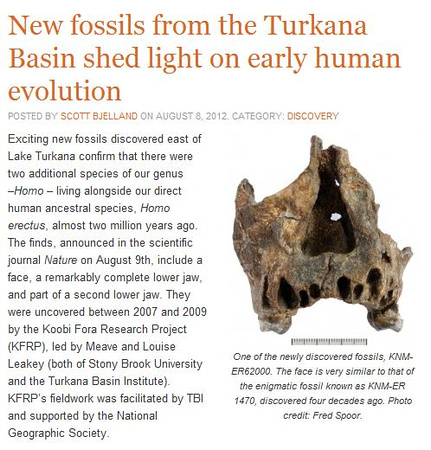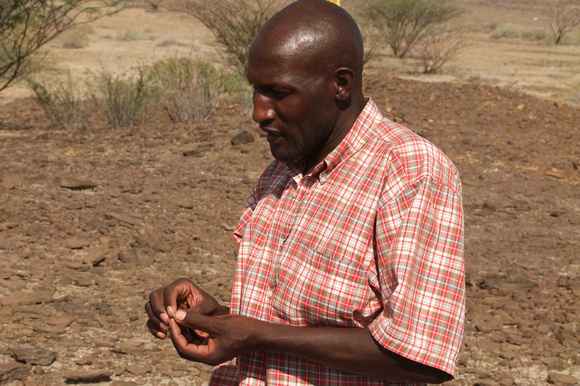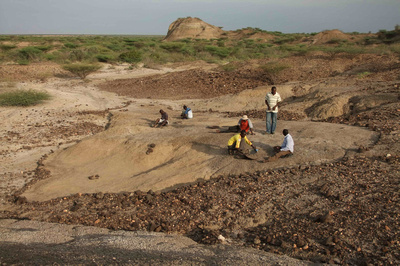A few words on the recently announced fossil discovery
Earlier this month, an exciting discovery of early hominid remains at Koobi Fora, East of Lake Turkana, Kenya, was reported in the journal Nature. The fossils described include a face with upper jaw of a juvenile individual, an almost complete mandible of an adult and part of a mandible of another individual, dated between 1.78 and 1.95 million years old. Through careful examination, the authors suggested a probable link between the newly found fossils and an enigmatic skull known as KNM-ER 1470 which features a similar long and flat face as the recent find. By comparing the shape of the jaws and teeth of the new fossils with those of the contemporary hominin species, the authors were further convinced that they might not belong to the relatively well represented Homo habilis, but more likely to Homo rudolfensis, the species assigned to the skull KNM-ER 1470.


Cover image for this discovery on Nature. See original article on Nature.
The fossils were found between 2007 and 2009 by the Koobi Fora Research Project (KFRP), led by Drs. Meave and Louise Leakey.
The new finds added key evidence regarding the long-lasting debate of how many species of Homo were roaming the East African lands about 2 million years ago. According to this report, it is very likely that in addition to Homo habilis and Homo erectus, there was a third species: Homo rudolfesis. The discovery has significant value in promoting the understanding of human origins and evolution. It might shed light on such questions as what could have happened in the evolutionary history that gave rise to such diverse morphological features within the genus Homo. Another intriguing concern would be how these three closely related species of Homo could have interacted in the company of each other.


See the official press release article on Turkana Basin Institute’s website.


View the new fossils in 3D on AfricanFossils.org.
This announcement has been reported by various news media and websites, and has drawn attention from far and wide. It is my greatest honor to share the delight of this success together with Meave, Louise and the field crew members on the very lands where these extraordinary fossils were unearthed.
It is undoubted that scientists did most of the contributions to our understanding of the past. But here, I would also like to give credit to the field crew members, taking advantage of being able to participate in the field explorations this year myself. It is through living and working closely together with them in the field that I can fully appreciate the importance of their enormous efforts. Indeed, no research could ever be done without their hard work and breathtaking discoveries in the field.


“I’m glad that you are going to write something about us fossil hunters”, said Cyprian Nyete, my colleague and personal friend who discovered that near-complete lower jaw in the 2009 field season. “Very few people know what we do and fewer wrote about our stories.”




While I am writing here sitting in the base camp at Ileret, a remote town at the Kenya-Ethiopia border, the field crew is still working hard out in the field. The fact that they endure the relentless sun, hostile environment and lots of sand and dust, is the best proof of their commitment to science, to a better understanding of the human lineage.


Honestly, I don’t really like the title “fossil hunter” so much, for it gives us a plausible impression of something similar to “treasure hunt”. However, fossil hunting does not have anything to do with the expediency of the fossil hunters. Fossils do have great value but only in realm of science. It is through all the efforts of walking miles on end under the hot sun on the vast fossil bearing areas of Northern Kenya that those fragile fossil remains could be identified and preserved. Otherwise, with constant erosion from the sun, rain, wind and the trampling of frequently passing herders and their animals, even the toughest fossils will perish. The fossil hunters are in fact walking on the front line of the waging war against such overwhelming forces. They are the “fossil savers”. (A following-up article about the life of fossil hunters is coming soon)
PS: Special thanks to Dr. Meave and Louise Leakey who granted me the chance to join the field crew in the field season this year, and to all KFRP field and camp crew members for their support.